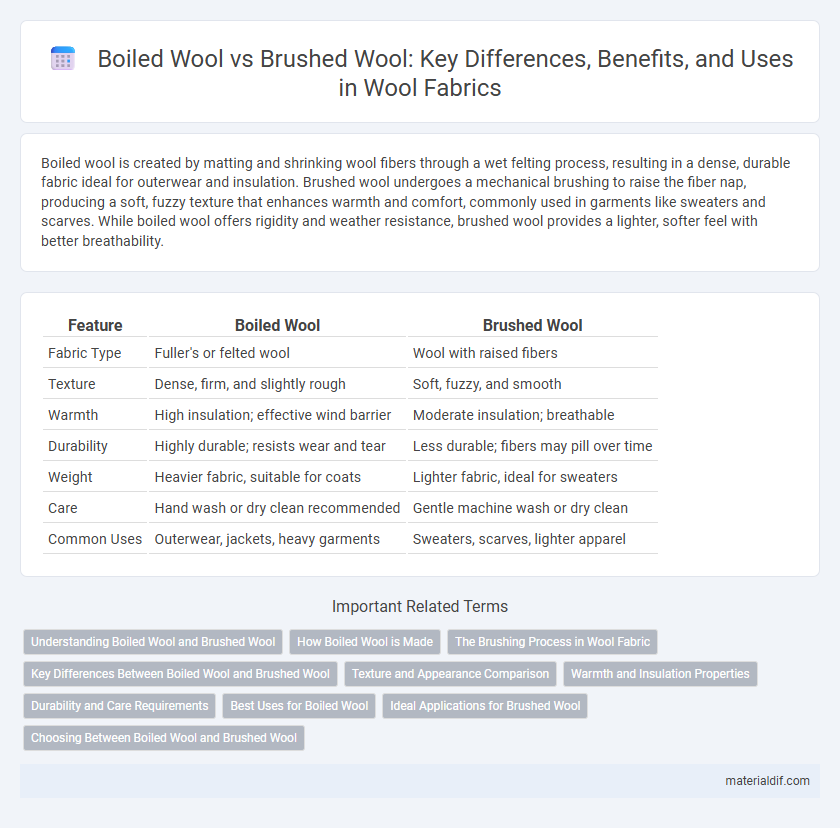Boiled wool is created by matting and shrinking wool fibers through a wet felting process, resulting in a dense, durable fabric ideal for outerwear and insulation. Brushed wool undergoes a mechanical brushing to raise the fiber nap, producing a soft, fuzzy texture that enhances warmth and comfort, commonly used in garments like sweaters and scarves. While boiled wool offers rigidity and weather resistance, brushed wool provides a lighter, softer feel with better breathability.
Table of Comparison
| Feature | Boiled Wool | Brushed Wool |
|---|---|---|
| Fabric Type | Fuller's or felted wool | Wool with raised fibers |
| Texture | Dense, firm, and slightly rough | Soft, fuzzy, and smooth |
| Warmth | High insulation; effective wind barrier | Moderate insulation; breathable |
| Durability | Highly durable; resists wear and tear | Less durable; fibers may pill over time |
| Weight | Heavier fabric, suitable for coats | Lighter fabric, ideal for sweaters |
| Care | Hand wash or dry clean recommended | Gentle machine wash or dry clean |
| Common Uses | Outerwear, jackets, heavy garments | Sweaters, scarves, lighter apparel |
Understanding Boiled Wool and Brushed Wool
Boiled wool is a dense, felted fabric created by repeatedly washing and agitating wool fibers, resulting in a thick, sturdy material ideal for outerwear and insulation. Brushed wool undergoes a mechanical brushing process that raises the fibers on the surface, producing a soft, fuzzy texture with enhanced warmth and comfort. Both fabrics retain wool's natural properties, but boiled wool offers durability and water resistance, while brushed wool emphasizes softness and breathability.
How Boiled Wool is Made
Boiled wool is created by repeatedly agitating wool fabric in hot water, causing the fibers to shrink and felt together, resulting in a dense, thick, and durable material. This felting process also enhances the insulation properties and water resistance compared to brushed wool, which is made by mechanically raising the fibers on the fabric's surface to create a soft, fuzzy texture without felting. The transformation in boiled wool involves controlled heat, moisture, and friction, making it ideal for outerwear and robust garments.
The Brushing Process in Wool Fabric
The brushing process in wool fabric involves raising the fibers using specialized brushes to create a soft, fuzzy surface that enhances warmth and texture. Unlike boiled wool, which relies on felting through heat and moisture to achieve density and durability, brushed wool maintains a lighter, loftier feel with increased insulation properties. This treatment also improves the fabric's breathability while providing a gentle, cozy hand suitable for garments that require softness without sacrificing structure.
Key Differences Between Boiled Wool and Brushed Wool
Boiled wool is produced by shrinking and agitating wool fibers through a hot water process, resulting in a dense, felted fabric with excellent insulation and water resistance. Brushed wool undergoes a mechanical brushing technique that raises the fibers, creating a soft, fluffy texture ideal for warmth and comfort but less dense than boiled wool. Key differences include texture, density, and water repellency, with boiled wool being thicker and more durable, while brushed wool offers a lighter, softer feel.
Texture and Appearance Comparison
Boiled wool features a dense, felt-like texture with a smooth, matte appearance created through a fulling process that shrinks and firms the fabric fibers. Brushed wool, by contrast, has a soft, fuzzy surface achieved by raising the nap, resulting in a warmer feel and a slightly lustrous, textured look. While boiled wool offers a structured and sturdy finish, brushed wool provides enhanced softness and visual depth, making each suitable for different types of garments and styles.
Warmth and Insulation Properties
Boiled wool offers superior warmth and insulation due to its dense, felted texture that traps heat effectively, making it highly resistant to wind and moisture. Brushed wool, while softer and lighter, provides good insulation by raising fibers for better air retention but is less dense than boiled wool. Both types excel in thermal regulation, but boiled wool is preferred in extreme cold conditions for maximum heat retention.
Durability and Care Requirements
Boiled wool is known for its exceptional durability due to the felting process that tightly bonds the fibers, making it resistant to wear and tear, ideal for outerwear and heavy use. Brushed wool, with its softer texture created by brushing the fibers, is less durable but offers a gentler feel and requires more delicate care such as hand washing or dry cleaning to maintain its appearance. Both types benefit from proper storage and minimal washing to prolong fabric life, but boiled wool generally demands less frequent maintenance.
Best Uses for Boiled Wool
Boiled wool is a dense, felted fabric created by matting and shrinking wool fibers, making it highly water-resistant and warm, ideal for outerwear such as coats, jackets, and capes. Its durability and windproof qualities also suit accessories like hats and mittens, providing insulation in cold weather. Unlike brushed wool, which is softer and lightweight for suits or sweaters, boiled wool excels in heavy-duty, cold-weather protection.
Ideal Applications for Brushed Wool
Brushed wool offers a soft, smooth texture and excellent breathability, making it ideal for lightweight garments such as suits, blazers, and dress pants worn in moderate climates. Its enhanced insulation and flexibility suit layering pieces and tailored clothing designed for spring and autumn seasons. Brushed wool's refined finish also lends itself well to fashion-forward apparel requiring both comfort and durability.
Choosing Between Boiled Wool and Brushed Wool
Boiled wool offers dense insulation and water resistance due to its unique felting process, making it ideal for outerwear and heavy-duty garments. Brushed wool, with a softer texture and increased breathability from the raised fibers, excels in comfort and warmth for sweaters and scarves. Selecting between boiled wool and brushed wool depends on the desired durability, warmth level, and garment type for optimal performance and style.
Boiled Wool vs Brushed Wool Infographic

 materialdif.com
materialdif.com